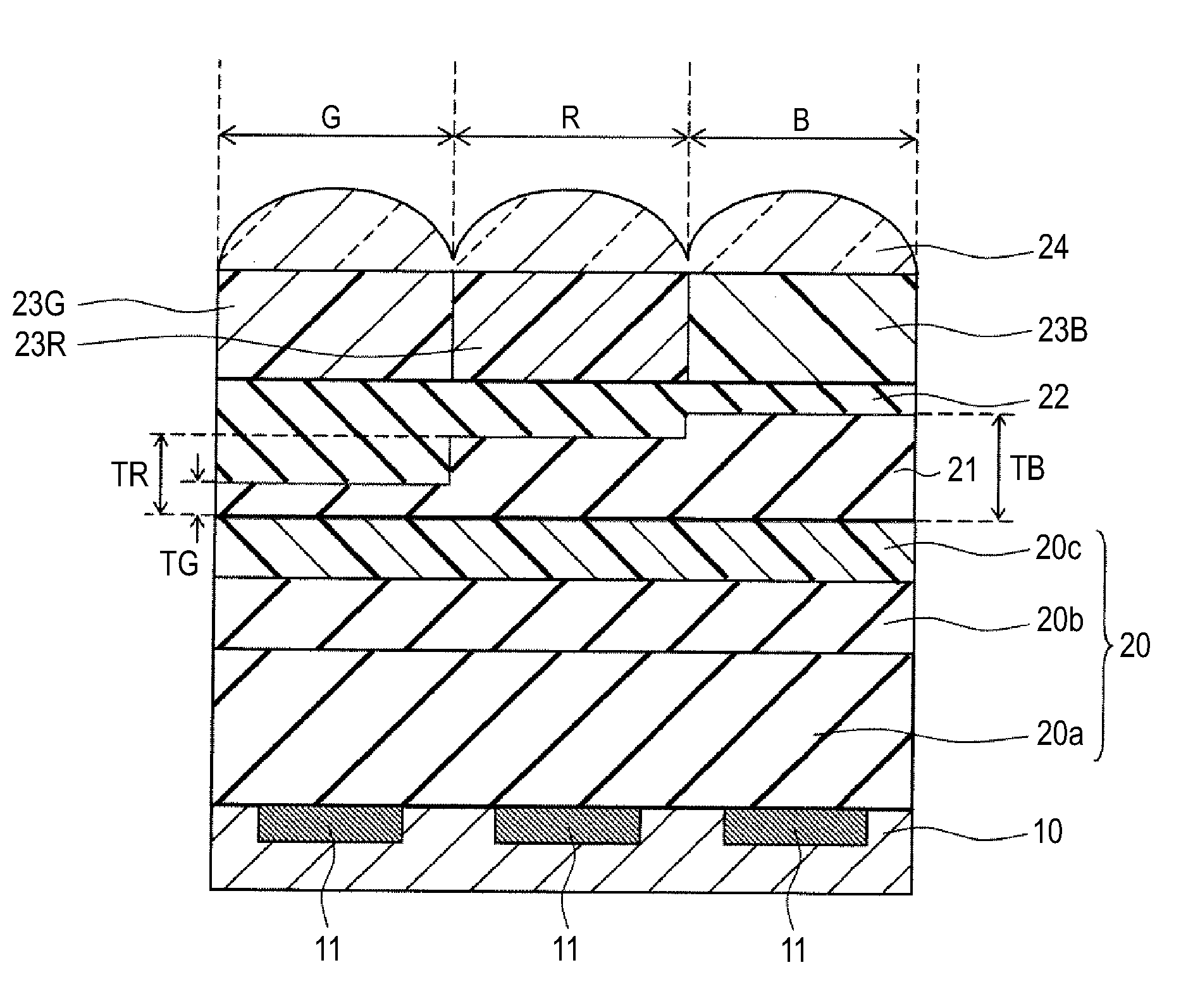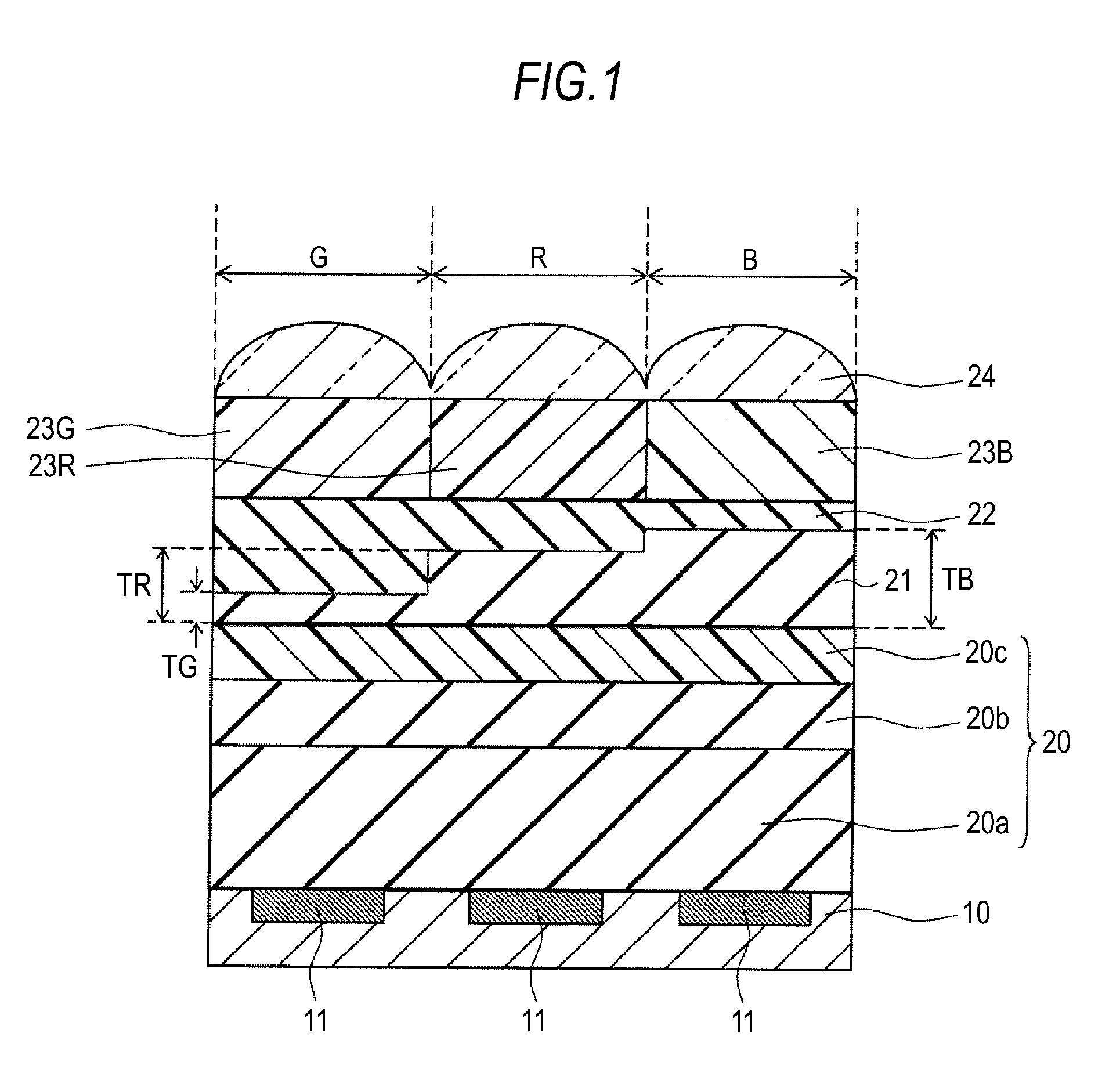Solid-state imaging device, manufacturing method and designing method thereof, and electronic device
a technology of solid-state imaging and manufacturing methods, applied in the direction of optical radiation measurement, radiation controlled devices, instruments, etc., can solve problems such as difficult suppression, and achieve the effect of suppressing color non-uniformity and reducing the variation in the optical interference intensity of incident light on the light-receiving surfa
- Summary
- Abstract
- Description
- Claims
- Application Information
AI Technical Summary
Benefits of technology
Problems solved by technology
Method used
Image
Examples
first embodiment
Configuration of Solid-State Imaging Device
[0089]FIG. 1 is cross sectional view of pixels of a solid-state imaging device according to the present embodiment.
[0090]The figure shows a red pixel (R), a green pixel (G), and a blue pixel (B) that receive, for example, the wavelengths of the red, green, and blue regions, respectively.
[0091]For example, the red pixel (R), the green pixel (G), and the blue pixel (B) receive the wavelengths of 620 nm, 550 nm, and 440 nm, respectively.
[0092]A photodiode 11 is formed for each pixel of a semiconductor substrate 10, and a gate insulating film of, for example, silicon oxide, and gate electrodes of, for example, polysilicon, are formed on the semiconductor substrate 10 in regions adjacent to the photodiodes 11. For example, transistors are formed for the transfer of signal charges that accumulate in the photodiodes.
[0093]In the present embodiment, the photodiodes are also called sensors, and the output intensity of the photodiodes is also referre...
second embodiment
Configuration of Solid-State Imaging Device
[0161]The solid-state imaging device according to the present embodiment is essentially the same as that described in First Embodiment.
[0162]FIG. 6 represents the relationship between the sensor intensity of the red pixel (R) and the thickness of the middle-layer first insulating film 20b under varying thicknesses of the second insulating film 21 over the range of 40 nm to 455 nm.
[0163]FIG. 7 represents the relationship between the sensor intensity of the green pixel (G) and the thickness of the middle-layer first insulating film 20b under varying thicknesses of the second insulating film 21 over the range of 40 nm to 455 nm.
[0164]FIG. 8 represents the relationship between the sensor intensity of the green pixel (G) and the thickness of the middle-layer first insulating film 20b under varying thicknesses of the second insulating film 21 over the range of 5 nm to 40 nm.
[0165]FIG. 9 represents the relationship between the sensor intensity of ...
third embodiment
Configuration of Solid-State Imaging Device
[0185]FIG. 11 is a cross sectional view of pixels of a solid-state imaging device according to the present embodiment.
[0186]The second insulating film 21 is configured as the laminate of three layers: a bottom-layer second insulating film 21a, a middle-layer second insulating film 21b, and a top-layer second insulating film 21c.
[0187]The other configuration is essentially the same as the solid-state imaging device of First Embodiment.
[0188]With the solid-state imaging device of the present embodiment, variation in the optical interference intensity of the incident light on the light-receiving surface can be reduced to suppress color nonuniformity, for example, in the generation of solid-state imaging device that forms color images particularly with a cell pitch of 3 μm or less.
[0189]The bottom-layer second insulating film 21a, the middle-layer second insulating film 21b, and the top-layer second insulating film 21c may be formed using the ...
PUM
 Login to View More
Login to View More Abstract
Description
Claims
Application Information
 Login to View More
Login to View More - R&D
- Intellectual Property
- Life Sciences
- Materials
- Tech Scout
- Unparalleled Data Quality
- Higher Quality Content
- 60% Fewer Hallucinations
Browse by: Latest US Patents, China's latest patents, Technical Efficacy Thesaurus, Application Domain, Technology Topic, Popular Technical Reports.
© 2025 PatSnap. All rights reserved.Legal|Privacy policy|Modern Slavery Act Transparency Statement|Sitemap|About US| Contact US: help@patsnap.com



